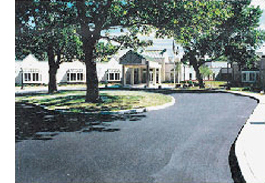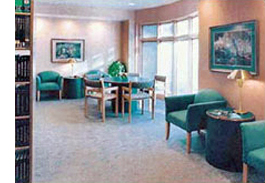 State Veterans Home, Batavia, NY" width="265" height="183" />
State Veterans Home, Batavia, NY" width="265" height="183" />Nursing homes serve patients requiring preventive, therapeutic, and rehabilitative nursing care services for non-acute, long-term conditions. Specialized clinical and diagnostic services are obtained outside the nursing home. Most residents are frail and aged, but not bedridden, although often using canes, walkers, or wheelchairs. Stays are relatively long, the majority for life. Nursing homes also care for a smaller percentage of convalescent patients of all ages. These patients are in long-term recovery from acute illnesses, but no longer require hospitalization.
Nursing homes, or sections of them, are often classified into intermediate and skilled nursing units, definitions related to Medicare/Medicaid standards. Intermediate-care facilities have just enough nursing to qualify for Medicaid; skilled nursing facilities meet the more demanding medical standards to qualify for Medicare as well as Medicaid support. The cognitively impaired are frequently housed separately in Alzheimer Related Dementia (ASD) units. See Alzheimer's Foundation of America Excellence in Care Program
 State Veterans Home, Batavia, NY" width="265" height="183" />
State Veterans Home, Batavia, NY" width="265" height="183" />
Western New York State Veterans Home, Batavia, NY
Photo Credit: Kideny Architects
Nursing homes present special design challenges in that for most residents the nursing home is not just a facility, but indeed their home. The reality is that in most cases the residents will live there for the rest of their lives and, moreover, rarely leave the premises at all. The nursing home becomes their entire world in a sense. The challenge is to design a nursing home that is sensitive and responsive to long-term human needs and well-being, both physical and emotional.
A nursing home operates primarily in a patient-care mode rather than a medical mode. Consequently, its more important attributes are those focusing on the general well-being of its residents rather than high-tech considerations. The principal attributes of a well designed nursing home are:
Inherent in any institutional stay is the impact of environment on recovery, and the long-term stays typical of nursing home residents greatly increase this impact. The architect and interior designer must have a thorough understanding of the nursing home's mission and its patient profile. It is especially important that the design address aging and its accompanying physical and mental disabilities, including loss of visual acuity. To achieve the appropriate nursing home environment every effort should be made to:

Missouri Veterans Home Library, St. James, Missouri
Photo Credit: Kennedy Associates/Architects
The nursing home design should:
An odor-free environment is a very high priority in nursing homes, since many residents are occasionally incontinent, and the pervasive odors can give an impression of uncleanliness and poor operation to family and visitors. In addition to operational practices and careful choice of furniture, facility design can help odor control by:
Floor plan of Missouri Veterans Home, St. James, Missouri. View enlarged plan.
Credit: Kennedy Associates/Architects
A consistent and well thought out system of way-finding helps to maintain the residents' dignity and avoid their disorientation. It should:
Many residents may be ambulatory to varying degrees, but will require the assistance of canes, crutches, walkers, or wheelchairs. To accommodate these residents, all spaces used by them, both inside and out, should:
Design to address security and safety concerns of nursing homes includes:
Aesthetics is closely related to creating a therapeutic homelike environment. It is also a major factor in a nursing home's public image and is thus an important marketing tool for both residents' families and staff. Aesthetic considerations include:
Nursing Home facilities are public buildings that may have a significant impact on the environment and economy of the surrounding community. As facilities built for "caring", it is appropriate that this caring approach extend to the larger world as well, and that they be built and operated "sustainably".
Section 1.2 of VA's HVAC Design Manual is a good example of health care facility energy conservation standards that meet Energy Policy Act of 2005 (EPACT) and Executive Order 13693 requirements. The Energy Independence and Security Act of 2007 (EISA) provides additional requirements for energy conservation. Also see USGBC's Leadership in Energy and Environmental Design (LEED) for Healthcare.
The Health Insurance Portability and Accessibility Act of 1996 (HIPAA) regulations address security and privacy of "protected health information" (PHI). These regulations put emphasis on acoustic and visual privacy, and may affect location and layout of workstations that handle medical records and other patient information, paper and electronic, as well as patient accommodations."
Like other buildings, nursing homes must follow the local and/or state general building codes. However, federal facilities on federal land generally need not comply with state and local codes, but follow federal regulations. To be licensed by the state, design must comply with the individual state licensing regulations. Many states adopt the FGI Guidelines for Design and Construction of Health Care Facilities as a resource, and thus that volume often has regulatory status.
State and local building codes are based on the model ICC IBC International Building Code. Federal agencies are usually in compliance with the IBC except NFPA 101 (Life Safety Code), NFPA 70 (National Electric Code), and Architectural Barriers Act Accessibility Guidelines or GSA's ABA Accessibility Standards takes precedence.
To care for residents who are reimbursed under Medicare or Medicaid, facilities must also meet federal standards, and to be accredited, they must meet standards of The Joint Commission. Generally, the federal government and The Joint Commission refer to the National Fire Protection Association (NFPA) model fire codes, including Standards for Health Care Facilities (NFPA 99) and the Life Safety Code (NFPA 101).
The Americans with Disabilities Act (ADA) applies to all public facilities and greatly affects the building design with its general and specific accessibility requirements. The Architectural Barriers Act Accessibility Guidelines or GSA's ABA Accessibility Standards apply to federal and federally funded facilities. The technical requirements do not differ greatly from the ADA requirements. See WBDG Accessible
Federal agencies that build and operate hospitals have developed detailed standards for the programming, design, and construction of their facilities. Many of these standards are applicable to the design of non-governmental facilities as well. Among them are:
Health Care Facilities lists generic health care facilities websites and publications